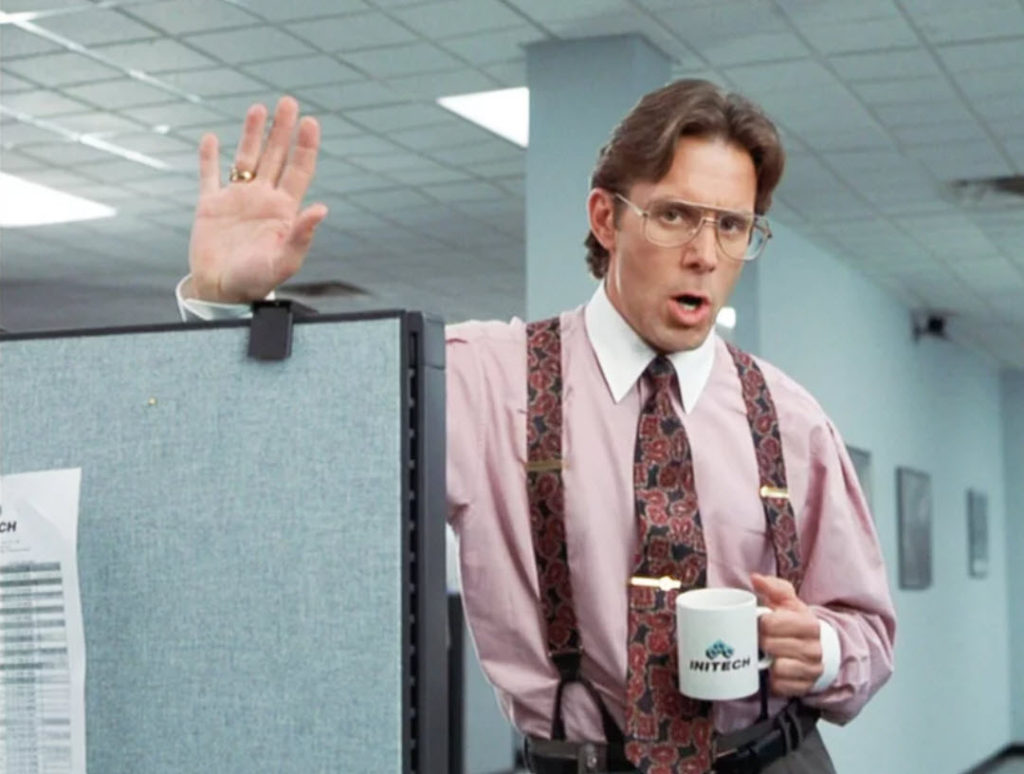
Today, the base pay of those at the top is commonly 400 times that of their salaried staff, with many earning orders of magnitude more in stock options and perks. The elite one percent of Americans control $30 trillion of assets, while the bottom half have more debt than assets. The three richest Americans have more money than the poorest 160 million of their countrymen. Fully a fifth of American households have zero or negative net worth, a figure that rises to 37 percent for black families. The median wealth of black households is a tenth that of whites. The vast majority of Americans — white, black, and brown — are two paychecks removed from bankruptcy. Though living in a nation that celebrates itself as the wealthiest in history, most Americans live on a high wire, with no safety net to brace a fall. With the COVID crisis, 40 million Americans lost their jobs, and 3.3 million businesses shut down, including 41 percent of all black-owned enterprises. Black Americans, who significantly outnumber whites in federal prisons despite being but 13 percent of the population, are suffering shockingly high rates of morbidity and mortality, dying at nearly three times the rate of white Americans. The cardinal rule of American social policy — don’t let any ethnic group get below the blacks, or allow anyone to suffer more indignities — rang true even in a pandemic, as if the virus was taking its cues from American history. COVID-19 didn’t lay America low; it simply revealed what had long been forsaken. As the crisis unfolded, with another American dying every minute of every day, a country that once turned out fighter planes by the hour could not manage to produce the paper masks or cotton swabs essential for tracking the disease. The nation that defeated smallpox and polio, and led the world for generations in medical innovation and discovery, was reduced to a laughing stock as a buffoon of a president advocated the use of household disinfectants as a treatment for a disease that intellectually he could not begin to understand. As a number of countries moved expeditiously to contain the virus, the United States stumbled along in denial, as if willfully blind. With less than four percent of the global population, the U.S. soon accounted for more than a fifth of COVID deaths. The percentage of American victims of the disease who died was six times the global average. Achieving the world’s highest rate of morbidity and mortality provoked not shame, but only further lies, scapegoating, and boasts of miracle cures as dubious as the claims of a carnival barker, a grifter on the make. ... Odious as he may be, Trump is less the cause of America’s decline than a product of its descent. As they stare into the mirror and perceive only the myth of their exceptionalism, Americans remain almost bizarrely incapable of seeing what has actually become of their country. The republic that defined the free flow of information as the life blood of democracy, today ranks 45th among nations when it comes to press freedom. In a land that once welcomed the huddled masses of the world, more people today favor building a wall along the southern border than supporting health care and protection for the undocumented mothers and children arriving in desperation at its doors. In a complete abandonment of the collective good, U.S. laws define freedom as an individual’s inalienable right to own a personal arsenal of weaponry, a natural entitlement that trumps even the safety of children; in the past decade alone 346 American students and teachers have been shot on school grounds.
The American cult of the individual denies not just community but the very idea of society. No one owes anything to anyone. All must be prepared to fight for everything: education, shelter, food, medical care. What every prosperous and successful democracy deems to be fundamental rights — universal health care, equal access to quality public education, a social safety net for the weak, elderly, and infirmed — America dismisses as socialist indulgences, as if so many signs of weakness. How can the rest of the world expect America to lead on global threats — climate change, the extinction crisis, pandemics — when the country no longer has a sense of benign purpose, or collective well-being, even within its own national community? Flag-wrapped patriotism is no substitute for compassion; anger and hostility no match for love. Those who flock to beaches, bars, and political rallies, putting their fellow citizens at risk, are not exercising freedom; they are displaying, as one commentator has noted, the weakness of a people who lack both the stoicism to endure the pandemic and the fortitude to defeat it. Leading their charge is Donald Trump, a bone spur warrior, a liar and a fraud, a grotesque caricature of a strong man, with the backbone of a bully.Over the last months, a quip has circulated on the internet suggesting that to live in Canada today is like owning an apartment above a meth lab. Canada is no perfect place, but it has handled the COVID crisis well, notably in British Columbia, where I live. Vancouver is just three hours by road north of Seattle, where the U.S. outbreak began. Half of Vancouver’s population is Asian, and typically dozens of flights arrive each day from China and East Asia. Logically, it should have been hit very hard, but the health care system performed exceedingly well. Throughout the crisis, testing rates across Canada have been consistently five times that of the U.S. On a per capita basis, Canada has suffered half the morbidity and mortality. For every person who has died in British Columbia, 44 have perished in Massachusetts, a state with a comparable population that has reported more COVID cases than all of Canada. As of July 30th, even as rates of COVID infection and death soared across much of the United States, with 59,629 new cases reported on that day alone, hospitals in British Columbia registered a total of just five COVID patients. -Rolling Stone
Which pretty makes it difficult for the “little guy”. You know the one. Like you and I. Where all we want is just to be left alone, do our best to provide for our families, and have a little bit of fun on the side.
And the purpose of a nation, any nation, is to support and protect a society of “little guys” who all are trying to “live life in the pursuit of liberty”.
But you and I both know, that that is not what America is today. It’s a multi-tiered concentration camp. With the strongest mob bosses at top and he rest of us toiling for some scraps that they toss below from their stratospheric heights.
So, is America so corrupted, so out-of-wack that a average, normal, decent guy can’t have a family, a life without working himself to an early grave?
Yes. That’s the way it is.
In the United States, as of 19FEB21. Life expectancy is how long a baby born today can expect to live, on average. For males it was 75.1 years and for females, 80.5 years. The current life expectancy for China in 2021 is 77.13 years, a 0.22% increase from 2020.
No kidding.
The American Military Emprie
Have you ever wondered what it was like to live within a Global Military Empire like Nazi Germany, The British Empire in the 1800’s, and Ancient Babylon? Well, it’s pretty much like the way Americans live today.
There’s always an external threat that needs a war to fight. There’s always an increase , ever rising, in the prices for goods and services, and there’s always a feeling like society is slipping and going down hill. David Copperfield describes the life during the British military empire. And if you add cell-phones, trailer parks, and food-stamps you have America today.

.
And while I can discuss about how one “Hellfire Missile” can build a ton-load of hospitals, rebuild bridges, and feed entire families for a year, consider what other nations are using their treasury dollars on.
I am inside of China, and they are using their monies to build roads, bridges, hospitals. They are upgrading all infrastructure, and building parks. They are updating ferries, and there is a the construction of a new Mag-Lev rocket-train, even faster than the high-speed trains (already criss-crossing the nation), that will go from Shenzhen to Shanghai in three hours. Faster than a direct flight!

Local clinics are getting state-of-the art blood analysis equipment and patient diagnostic equipment. Clinics! Not like the USA where you need to get a doctors appointment to get you a hospital appointment, to get an analysis appointment to have anything done.
Blood work for my child, yesterday, occurred in 15 minutes. On site at a clinic. The entire cost was free. Because we are residents of the community. How much would it cost for us int he USA? How long would it take?
That is the difference between a nation that is investing in it’s people, and a Military Empire.
Sent to me by an influencer…
Back to the subject – Work & Life
I argue that when you live in a bad environment, whether it is a military empire, or a concentration camp, you are unable to find a work/life balance. It is just simply not possible. You have either one thing or the other thing. There is no balance.
So people find work-arounds.
If they do not, then they spend their entire life working and them when they reach retirement, they make do with what ever systems the government has in place for their retirement. And for Americans, it’s not good at all.
OK. Here’s a good article about this subject.
All credit to the author, reposted as found. No editing except to fit within this venue.
How to Come to Terms With Working For the Rest of Your Life

This is a question every man has to answer,
How did you come to terms with working full-time for the rest of your life?
I graduated from college this past May and just started my full-time job three weeks ago. I am a salaried employee with a required minimum of 50 working hours per week.
I’m grateful to have a job, but how the hell did you accept the fact that you’ve essentially been born to work? I see very few routes outside of working what feels like endless hours until I’m 60 (optimistic!) and can retire… to just sit around all day because I’m too old to do much of anything else
My friend, 60 is VERY optimistic if you just got out of college because the chances Social Security will be around in its current form by then is basically nil. That means most people that age are likely to work until they die.
All that said, there are a lot of options for what you can do on the working front. In fact, it gets back to my all-time favorite quote.
“There are no solutions. There are only trade-offs.” — Thomas Sowell
The best jobs require a lot of hours. You want to be a CEO, run a successful small business, or be a doctor, you are going to put in some serious hours to do that. You want the big house, the money, the prestige, you are going to have to work for it. You want to live somewhere expensive like NYC or San Francisco, then you should be prepared to work like a dog to make it happen.
If you are willing to forego that and make some lifestyle trade-offs, you may be surprised at what you can do.
For example, if you are outside of the big cities, you can live pretty well working 40 hours a week. Over time, especially if you get married to a woman that works, you can get yourself a house and have a vacation a year, a big-screen TV, and generally live comfortably. If you’re frugal, you can even save up some money doing that. Unfortunately, most people in that position aren’t frugal and they struggle when they get an unexpected bill, but that doesn’t have to be you.
You can take it even further if you like. Back in the day, I once had a roommate who has a fantastic salesman. He worked half the year selling and took the other half of the year off. If you want to live with roommates and keep it cheap, you may be able to squeak by working part-time. If you want to live out in the boonies with a little garden out back and some convenient land nearby for hunting and fishing, you may not have to work forty hours per week to do it.
What all this means is that you have real options in life. It just depends on which trade-off you want to make and guess what? The one with the most hours probably isn’t the best for everyone. There are guys who wake up one day in their forties with lots of money, but bad health and no one that cares about them because they have been working 70 hours a week from the time they were young until now. Are they better off than the guy who worked 20 hours a week his whole life, but took care of himself, had friends, and had a happier life? That’s a question you have to ask yourself.
It begins by asking what motivates you, what you want to have in your life and how much of your life you are willing to trade to make that happen.
And isn’t that the case?
What are you going to do? Work like a crazy madman on the quest to become another Donald Trump, Bill Gates, or Steve Jobs? So that you can sit upon billions and billions of dollars, while the nice day beckons outside, the fish are biting, and the cute girls would dearly wish that you would ask her out for a stroll on the beach and a cup of coffee.
Where are your friends? Where are your family in all this? Is that all there is to life? Work as some kind of corporate drone, and then retire as a starving old man?
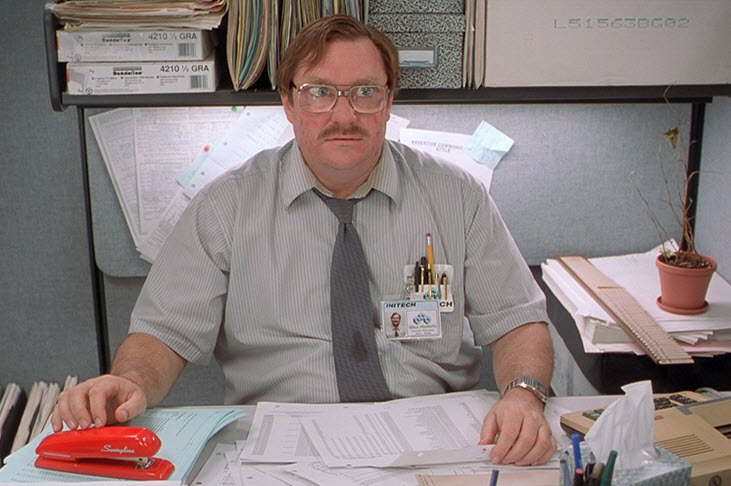
Maybe there is another way… or, not.
We really need to take a good hard look at what the work environment is inside of America today. And compare it to the work environment in the rest of the world. And let me tell you… it is not pretty.
The following article is reprinted in it’s entirety, and edited to fit this venue. All credit to the authors.
“I’m gonna need you to come in on Saturday”: How “Office Space” got the modern workplace just right
Cubicles, layoffs, TPS report, flair — “Office Space” bombed at the box office, but endures because it was right
By Nikil Saval
The office could be any office. Cove fluorescents on a dimmer, modular shelving, the desk practically an abstraction. The whisper of sourceless ventilation. You are a trained observer and there is nothing to observe. —David Foster Wallace, "The Pale King"
After the stock market crash, which emptied out the lofts and warehouses of San Francisco, eroding in an instant the frictionless, cloud-kicking fantasies of the dot-commers, another white-collar recession slung into place, and the office seemed to resume its role as the workplace everyone loved to hate.
Few cultural objects expressed this miasma of ill will better than the film “Office Space,” which appeared in 1999 at the very peak of the boom. Its theatrical run was a modest failure, but in retrospect it’s no surprise that a film so relentlessly dark and nasty would be overpowered by the delirium that gripped the end of the millennium.

(From a reporter visiting a Microsoft annual meeting in 1997: “‘Why are we at Microsoft? ’ bellowed billionaire Steve Ballmer, then the company’s executive vice president, to a crowd of nine thousand employees packed into the Kingdome, Seattle’s indoor stadium. ‘For the money! ’ he screamed. ‘Show me the money! ’ The crowd responded with a roar: ‘Show me the money! ’ ”)
Running gags about staplers, misplaced memos, “Hawaiian Shirt Day,” and the specter of working lives wasted in dead-end, purposeless jobs for a gray tech company: no one appeared ready for that sort of humor in an era of raging exuberance—and anyway, the cubicle was dead, right?
Then the bubble burst; people woke up the following morning with their stock options erased; the beanbag chairs were gone, and they were in a cubicle again or unemployed and desperately searching for a cubicle. “Office Space” found new life on the small screen, a medium that suited the office worker existence depicted in the film: long days huddled in front of a computer, followed by short nights exhausted on the couch, staring at a television.
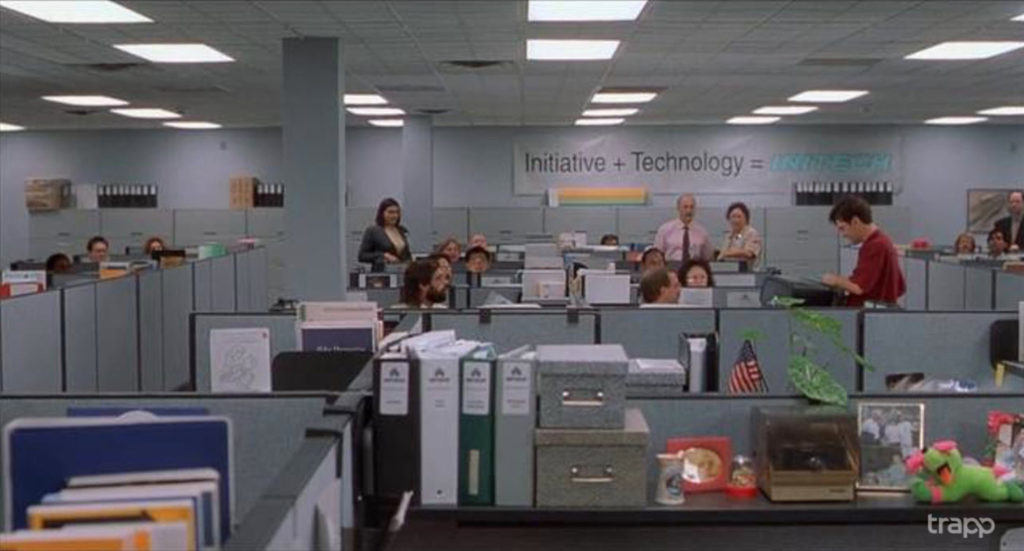
In 1999 it barely recovered its $10 million budget in box office receipts; by 2003, it had become a cult classic, with more than two and a half million copies sold on video. (It screens on Comedy Central with the sort of mindless regularity that suggests a bored television office staff behind it all. “What do we fill the 2 to 5 p.m. slot with? ” “Fuck it, let’s just put on ‘Office Space’ again.”)
Everyone knows very happy white-collar people who can quote “Office Space” with as much fervor and accuracy as a pastor does the Gospels, and it’s a plausible and routine assumption that repeated watchings of the film might offer a kind of therapy for stressed office workers: a vent for an inarticulate rage that helps keep them humming away at bad jobs.
But anecdotally, at least, it’s led to people quitting their jobs, and one Portland, Oregon, webmaster started a site, Bullshit Job, that doubled as both a tribute to the film and a page where workers could post all the insulting memos and e-mails their bosses sent out.
In other words, “Office Space,” and subsequent works in the general fraternity of office satire, helped office workers recognize themselves as belonging to a particular kind of group—a recognition that the office always seemed to deny, since no matter where you were in the office, you were always presumed to be on your way up. (Think of that line from the Stanwyck film: “Baby Face is moving out of your class.”) And part of the brilliance of the film was its insistence that the jobs weren’t bad simply because the office workers were oppressed: they were intrinsically bad jobs, in a bad environment.
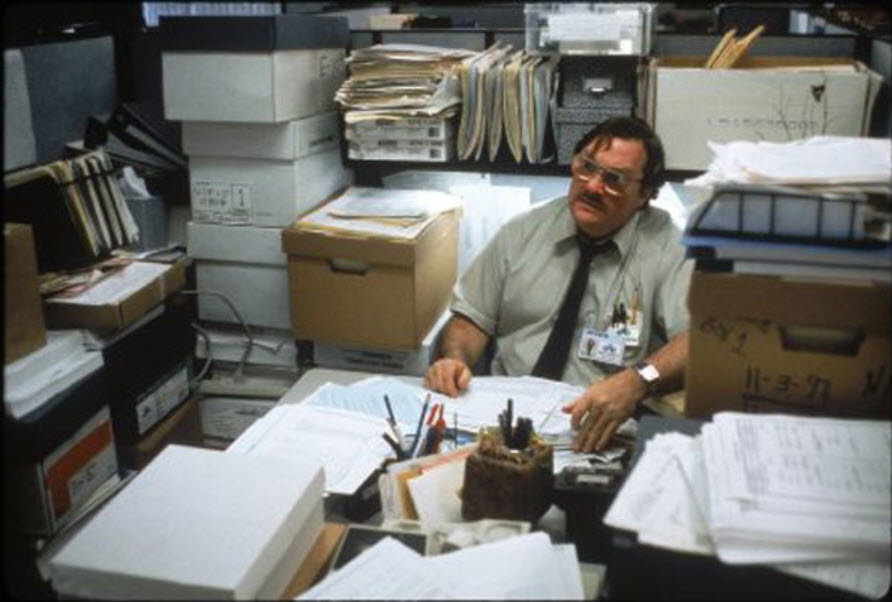
The setup for “Office Space” represents a larger shift in the understanding of office life. The paradigmatic narrative had been the entry of the rural woman into urban white-collar life, with its attendant sexual terrors; by mid-century, it was the travails of the middle manager attempting to avoid the conformist spirit of organizational life. But the plot of “Office Space”—reflecting the larger changes in the American economy—is about people being forced to leave an environment they hate, through layoffs; the same is true of the British show “The Office” (called, in an even more insulting euphemism, “redundancies”) and of the recent American novels of office life “Then We Came to the End” and “Personal Days.”
The prospect of losing one’s job forces the personal crisis: you come to know who your friends are, what your loyalties are worth, and what your job really is.
In “Office Space,” consultants come to examine the company’s structure to give it a leaner form; though their method is unjust, they really do find people working useless jobs:
BOB SLYDELL ( JOHN C. McGINLEY) : What you do at Initech is you take the specifications from the customers, and you bring them down to the software engineers. TOM SMYKOWSKI (RICHARD RIEHLE) : Yes, yes, that’s right. BOB PORTER (PAUL WILLSON) : Well, then, I have to ask—why couldn’t the customers just take them directly to the software people? TOM: I’ll tell you why. Because engineers are not good at dealing with customers. SLYDELL: So you physically take the specs from the customer? TOM : Well . . . no, my secretary does that. Or the fax. PORTER : So then you must physically bring them to the software people? TOM : Well, no. I mean, sometimes. SLYDELL: What would you say you do here?TOM : Well, look, I already told you. I deal with the goddamn customers so the engineers don’t have to. (Screaming.) I have people skills! I am good at dealing with people! Can’t you understand that? What the hell is wrong with you people?
Tom Smykowski is defensive about his job, even though he can’t explain what it is he does. Peter Gibbons (Ron Livingston), the main protagonist, knows that his job—updating software for the Y2K switch—sucks, and he knows that it’s meaningless; from the vantage point of the new millennium, it seems especially useless.
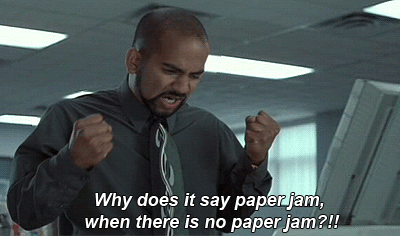
Struggling to explain it to a waitress, Joanna (Jennifer Aniston), he says, “I sit in a cubicle, and I update bank software for the 2000 switch. Well, see they wrote all this bank software, and to save space they used two digits instead of four, so like 98 instead of 1998, uh, so I go through these thousands of lines of code and uh . . . It doesn’t really matter. I don’t like my job.”
Later Peter confesses to the consultants that his average workday consists of coming in fifteen minutes late and “just sort of spac[ing] out for about an hour . . . I do that for about another hour after lunch too. I’d say in a given week, I only do about fifteen minutes of real, actual work.”
The twist is that this honesty is exactly what the consultants prize—a kind of ironized version of the “truth-telling” organization man of “The Man in the Gray Flannel Suit.” Though Peter stops showing up to work and wrecks his work space by dismantling his cubicle walls, the consultants offer him a promotion. “[He’s] just a straight shooter with upper management written all over him,” one consultant says to Peter’s boss.
In return, however, they fire two engineers with actual experience, who happen to be Peter’s friends. This sets in motion the increasingly madcap (and implausible) third act, when Peter and his laid-off friends try to program a virus that would scam the company they despise out of thousands of dollars. At the end of the film, one of the company’s disgruntled employees, the sublime mutterer Milton Waddams (Stephen Root), sets the building on fire.
Peter’s engineer friends have moved from Initech to its competitor Initrode; Peter himself takes a blue-collar job in construction—preferring the outdoor life to his stationary warren of cubicles.
“Office Space” occupies such a tremendous place in the American office worker’s imaginary about his workplace it’s a shame that its effect—or the effect of the larger discourse it’s a part of—has tended to be shallow and focused on the cubicle and dumb bosses.
The “space” in “Office Space” was largely a symbol—of an uncaring, even ruthless organization.
Its real targets were the unholy expectations of the modern workplace, which asked for dedication and commitment, offering none in return.
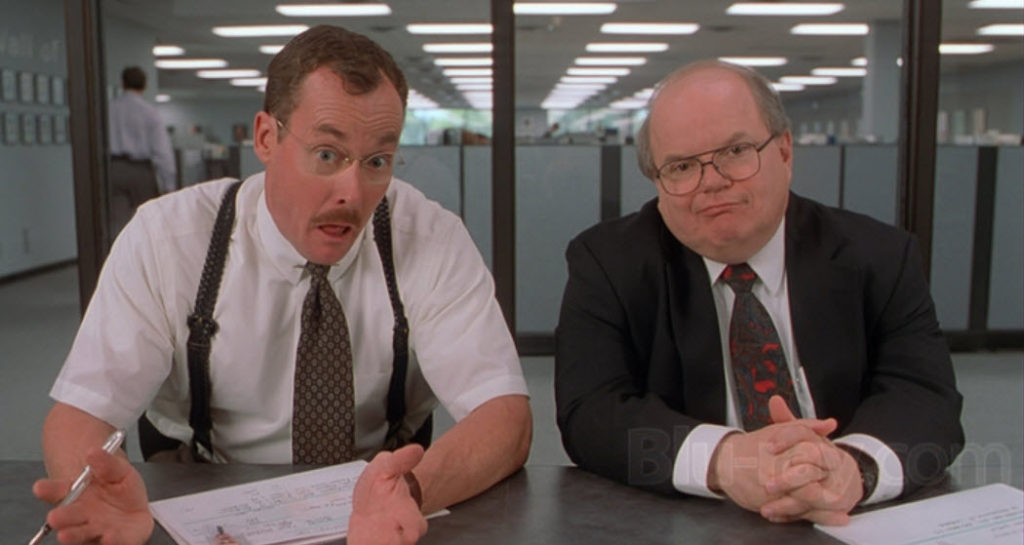
It doubled the force of its condemnation by extending it to other kinds of workplaces. The waitress Joanna works in a chain diner called Chotchkie’s, whose absurd expectations closely resemble those of the office. Part of her job involves donning wacky buttons with slogans and symbols on them, called “flair.” At one point, her boss takes her aside to chastise her about her flair.
STAN (MIKE JUDGE) : Joanna! . . . We need to talk about your flair. JOANNA : Really? I have fifteen pieces on (demonstrating). STAN : Fifteen is the minimum, mmkay. It’s up to you whether you want to just do the bare minimum. Brian for example has thirty-seven pieces of flair—and a terrific smile. JOANNA : Okay, so you want me to wear more? STAN : (Sighing.) Look, Joanna, people can get a cheeseburger anywhere, they come to Chotchkie’s for the atmosphere and the attitude. That’s what the flair’s about. It’s about fun. JOANNA : So . . . more, then. STAN : Look, we want you to express yourself. Mmkay? Now, if you feel the bare minimum is enough, well, okay, but some people choose to wear more, and we encourage that. You do want to express yourself, don’t you?
Joanna’s boss occupies the same place as the office consultants: looking for intangible, personality-based outward expressions as signs of being a “straight shooter”—rather than establishing obvious benchmarks that one meets simply to garner a paycheck.
Her suspenders laden with flair suggest nothing so much as cubicle walls, decked out to show one’s “individuality.” The human attachments in “Office Space” were so strange and obsessive—Milton and his now infamous need to keep his red Swingline stapler—that it was hard to believe there was anything still left to express.
Those still immune to the satire of flair, however, are encouraged to check out the catalogs of the office supplier Baudville, which offers, among other choice items, rhinestone-encrusted lanyards as well as T-shirts for appreciation weeks with slogans like “Smells like Team Spirit” and “I Put the ‘Zing’ in Amazing.”
After such knowledge as “Office Space” offered, what orgiveness? How could one acknowledge the essential failure of the office to deliver on its promised utopia—and go on as if nothing had happened?
For many, the question was merely rhetorical: they were out of work and stringing together temporary gigs as best they could. But for others, the dream of a better office lived on in different ways: some saw technology as still offering a way of moving office work out of the office, into a broader sphere of public life; others saw that the office needed to be made vastly more humane and responsive to its increasingly apathetic denizens.
These two paths were united by a single goal: the desire to make work enjoyable, to return it to an innocence that generations of workplace mistakes had rendered corrupt.
In an arresting and bleak phrase, the sociologist Max Weber had described the progress of rationality and scientific demystification as leading to a gradual “disenchantment of the world.” Something like that had happened to office work: the rosy image of the office as a distinct, and distinctly middle-class, alternative to the travails of factory work and other manual labor had suffered too many jolts to survive. The office would have to be re-enchanted.
Excerpted from “Cubed: A Secret History of the Workplace” by Nikil Saval.
Nothing new, right?
Ah. You all know about this, and have watched the movie.
And maybe things are changing… at a glacial pace. For those of you who have planned a life independent of the corporate treadmill, you are truly fortunate. You own your own businesses and define your hours to your own liking and your very own familial needs.
But for the rest of us…
…those that were taught in our public schools that the key for success was working hard, getting good grades and working for a company that would take care of us… (and provide us with a great pension)…
…what of us?
What of us?
Where is our “life balance”?
American Work-Life Balance
- According to the Center for American PROGRESS on the topic of work and family life balance, “in 1960, only 20 percent of mothers worked. Today, 70 percent of American children live in households where all adults are employed.”. U.S. Department of Labor statistics back up this data, and notes that 75% of those women working full time. I don’t care who stays home and who works in terms of gender (work opportunity equality for all – it’s a family choice). Either way, when all adults are working (single or with a partner), that’s a huge hit to the American family and free-time in the American household.
- The U.S. is the ONLY country in the Americas without a national paid parental leave benefit. The average is over 12 weeks of paid leave anywhere other than Europe and over 20 weeks in Europe.
- Zero industrialized nations are without a mandatory option for new parents to take parental leave. That is, except for the United States.
American Average Work Hours:
- At least 134 countries have laws setting the maximum length of the work week; the U.S. does not.
-
In the U.S., 85.8 percent of males and 66.5 percent of females work more than 40 hours per week.
- According to the ILO, “Americans work 137 more hours per year than Japanese workers, 260 more hours per year than British workers, and 499 more hours per year than French workers.”
- Using data by the U.S. BLS, the average productivity per American worker has increased 400% since 1950. One way to look at that is that it should only take one-quarter the work hours, or 11 hours per week, to afford the same standard of living as a worker in 1950 (or our standard of living should be 4 times higher). Is that the case? Obviously not. Someone is profiting, it’s just not the average American worker.
American Paid Vacation Time & Sick Time:
- There is not a federal law requiring paid sick days in the United States.
- The U.S. remains the only industrialized country in the world that has no legally mandated annual leave.
- In every country included except Canada and Japan (and the U.S., which averages 13 days/per year), workers get at least 20 paid vacation days. In France and Finland, they get 30 – an entire month off, paid, every year.
- Then there’s this depressing graph on average paid vacation time in industrialized countries:
The Impact of Too Much Work
I’m not telling you to work less hours. If you genuinely love what you do and are doing it for the right reasons, you are more than entitled to spend all of your waking hours plugging away.
But for many of us, more work leads to more stress and a lower quality of life. Without time to unwind, take care of your home, spend time with loved ones, enjoy our hobbies, connect with friends, and generally live a more balanced life. Stress is the #1 cause of health problems – mentally and physically. And there are few things that stress us out on a consistent basis like work does, especially when it takes away from all of the other things that life has to offer.
Americans are the Outliers
And if all of this data tells anything, it’s that we are the outliers, not the norm. Why are we the outliers?
- Our companies fairly ruthlessly let people go. We want to keep our jobs and not be a ‘low performer’ compared to others.
- The decline of the union has led to less paid time off and other leave benefits.
- Cultural value of money over everything else. We love money, we want more of it, and we think money can buy happiness. And the more we work, the more we get paid.
- It’s been drilled in our heads that we are lazy compared to emerging market counterpart workers in India, Mexico, China, and other parts of Asia. Who isn’t? And what is our mental image of the work environments in those locales? To validate those fears, our jobs are being outsourced to the cheap labor in those countries. In reality, the U.S. trails only Norway and Luxembourg (2 tiny countries) productivity per person.
- Our legislative branch of the government (on both sides of the aisle) has been bought and as a result has shied away from passing laws that protect workers that every other industrialized nation has passed.
- We generally don’t fight for our working rights. We take what is given to us.
What we All Need to Remember
What we all need to remind ourselves is that it doesn’t have to be this way.
- It’s OK to ask to move to fewer hours at work.
- It’s OK to take a week-long vacation if we need to.
- It’s OK to ask to work from home.
- It’s OK to take a month of unpaid leave while you raise a child.
- It’s OK… you get the idea.
Don’t let life pass you by in the name of fear, circumstance, greed, or misguided hopes. Sometimes you just need to draw a line in the sand and say “enough is enough”.
And yeah.
I can hear it now…
If you don't like America so much, then leave. 'Merica is the best! Rah Rah Rah.

U.S. Americans’ Work-Life Balance Is Exceedingly Imbalanced
Research shows many Americans who receive paid time off are afraid to take it because of workplace pressures. But it turns out the European vacation mindset could actually help boost productivity.
The European Union’s Working Time Directive guarantees EU workers at least 20 paid vacation days per year, contrary to the United States, which does not have a statutory minimum annual leave requirement. Some European countries mandate additional time off; the UK, France, Austria, Denmark, Finland, Luxembourg, and Sweden all require 25 or more paid annual leave days. OECD data shows more time off doesn’t have to translate to lower productivity. On the contrary, some of the most productive countries, measured by GDP per hour worked, were in Europe.
The United States ranks far lower.
And don’t tell me that there are worst places in the world. Sure there are. But that is not the issue. The issue is [1] what is going wrong, and [2] how to fix it.
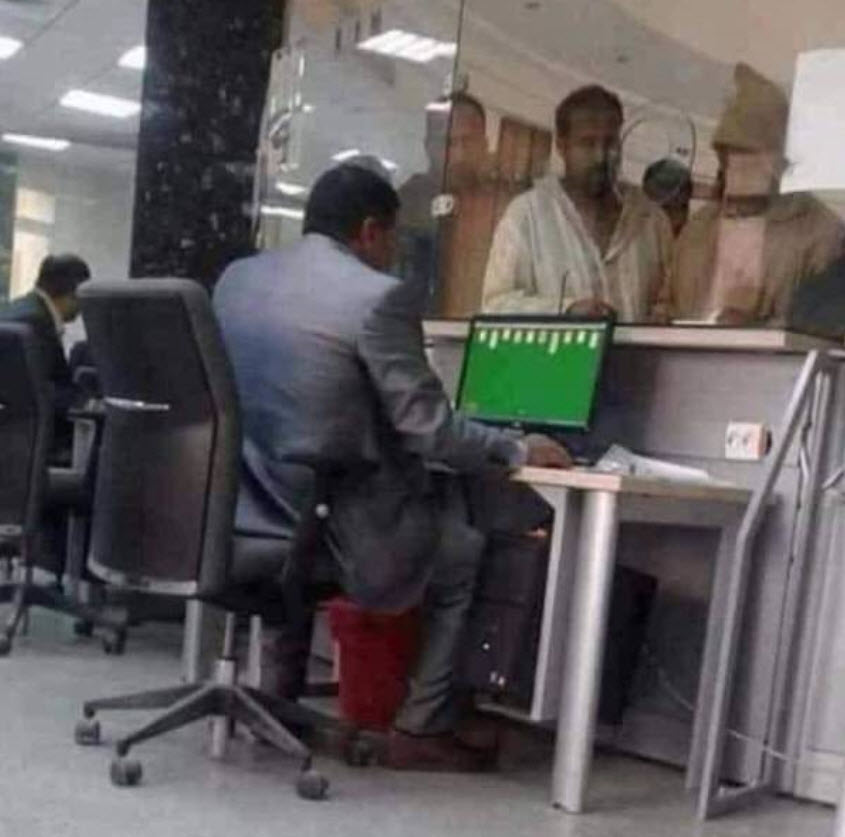
Belgium
Workers here enjoy an average of 8.6 hours of leisure per day—which trumps their 7.4-hour work days. Locals really value quality family time, getting home in time for dinner each night, and taking a full month-long vacation over the summer to coincide with school breaks.
Austria
Many offices in Austria have an 8–5 workday—except for Fridays, when employees are encouraged to go home at 3 p.m. Never ending “summer Fridays” aside, the country is also one of the best in the world for people looking to relocate; 80% of expats in Austria said their work-life balance improved since moving there (compared to the 53% global average).
Germany
The German government has several regulations in place to make sure its citizens don’t overwork themselves. And the work-hour regulations (Arbeitszeitgesetz) state that workers cannot put in more than 48 hours a week—or work Sundays or national holidays.
Luxembourg
Working on Sundays is outlawed in Luxembourg (though exceptions include maintenance and security jobs). The country also scores well in the sleep and vacation departments, with citizens getting an average of 7.2 hours of sleep per night and a minimum of five weeks paid annual leave—in addition to national holidays.
Spain
Although many employees do not take advantage of early afternoon siestas there is still an annual vacation allowance of 30 days.
France
French workers spend the most time—9.3 hours per day—devoted to leisure and relaxation. In 2017, France also introduced a law that allows workers the “right to disconnect” from afterhours work emails.
The French work hard, but the OECD thinks that gender inequality in the workplace is holding it back. While 78 percent of women work full-time, they say, “access to the labour [sic] market of mothers of young or large families could be improved but would likely require a more equal share of caring activities between parents.” In other words, women could be having a better work-life balance in France if their partners stepped up their childcare and were given longer paternity leave, and other support structures from their employers. That’s also a factor that affects U.S. families, where paid paternal and maternal leave aren’t mandated by national law.
Finland
At first glance, work hours in Finland look pretty similar to those in the United States: Monday through Friday, 8–5. However, their lunch breaks are one to two hours long. A great advocate of healthy living and rejuvenation, the government gave its citizens four “Nature Days” to celebrate its 100th birthday outdoors.
The Netherlands
Although the Netherlands only gives workers nine bank holidays per year, they compensate with the shortest work week of all the countries surveyed (averaging at 30.3 hours). Add to that 20 to 25 annual vacation days and extremely generous parental leave policies, this makes the Netherlands one of the highest-ranking countries for employees to enjoy a good work-life balance.
According to the OECD, the Netherlands had the best work-life balance in 2018, with Denmark, last year’s winner, losing out narrowly. In every area, the Dutch came out on top.
One of the big factors for the Dutch, says the OECD, is hours worked. “In the Netherlands, less than 0.5 percent of employees work very long hours, the lowest rate in the OECD where the average is one percent,” they write. About one percent of men work very long hours, compared with almost no women.” They define “long hours” as over 50 hours per week.
In the U.S., by comparison, the OECD says that 11 percent of employees put in long slogs, including 16 percent of men and 7 percent of women. The Netherlands has strict working week laws to prevent people working over 60 hours. Dutch culture doesn’t put as much emphasis on working till you’re exhausted, writes Business Culture, and encourages leaving leisure time. “They have clearly defined working hours and they respect them,” Business Culture writes.
You can take sick leave for up to two years and still receive 70 percent of your salary, according to a survey by the employment site Glassdoor. It’s the most generous sick-leave policy in Europe. Compared to the U.S., where there is no policy, it frankly boggles the mind.
Sweden
Sweden enjoys 25 annual vacation days, along with 16 months of paid family leave and 14 bank holidays per year, making it one of the more generous countries in terms of in Europe for employees.
Prisons in Sweden are meant to rehabilitate criminals, which helps explain why the country’s recidivism rate—how frequently people return to prison—is so low. In 2014, it was 40 percent, about half that of the U.S. And Swedish penitentiaries more closely resemble American offices or college dorm rooms than they do prisons, according to The Guardian.
Denmark
Denmark balances salary against cost of living well, and average daily leisure hours (8.8 per day) way outnumber work hours (6.6 per day). According to U.S. News & World Report, this is also the 2nd best country in the world to raise children. Both mothers and fathers are entitled to 23 weeks of parental leave, plus mothers get an extra four weeks of leave before their expected due date.
Unemployed workers in Denmark get 90 percent of previous earnings for up to 104 weeks, the most generous unemployment benefits in the EU, the Glassdoor survey said. This far outpaces the U.S., where unemployment pays 40 to 50 percent of earnings for up to 26 weeks.
Only 0.5% of Dutch employees regularly work very long hours, which is the lowest rate in the OECD, where the average is 13%. Instead, they devote around 16 hours per day to eating, sleeping and leisurely pursuits.
The Netherlands also boasts very low rates of youth unemployment, high literacy levels, below average levels of child income poverty and high levels of life satisfaction in childhood – over 93% of 11-15-year-old children report above average life satisfaction, for instance.
Work responsibilities are also shared among Dutch families, with the number of women in employment doubling from 35% in the early 1980s to 69.9% today, which is well above the OECD average of 57.5%.
There is also a strong sense of community in the Netherlands, where 90% of people say they know a friend or family member they could count on in times of trouble. This is slightly better than the 89% reported across other OECD countries.
Australia
The OECD reports that “when asked to rate their general satisfaction with life on a scale from 0 to 10, Australians gave it a 7.3 grade on average, higher than the OECD average of 6.5.” In the U.S., the grade is 6.9. Comparatively, though, Australia isn’t actually that good at work-life balance.
“Full-time workers devote 60 percent of their day on average, or 14.4 hours, to personal care (eating, sleeping, etc.) and leisure (socialising [sic] with friends and family, hobbies, games, computer and television use, etc.) — less than the OECD average of 15 hours,” says the OECD. It’s only just behind the U.S. in work-life rankings, ranking 32nd to the U.S.’s 31st. Less time for leisure and fun means a less balanced, more stressed country.
Brazil
In Brazil, work-life balance goes in a different direction: while only 7 percent of workers work long hours, the average income is significantly lower than the OECD average, and 64 percent of people have a paid job, compared to 69 percent in the U.S. The Brazilian economy is recovering from a slump, which is why working hours are currently a bit lower than other countries.
Ugh!
The average American works a staggering 1,836 hours a year, which is a good deal more than most of the world. Something something, the American Dream, blah blah blah. But with all that time put in at the office, Americans surely get loads of vacation days to keep them productive and not just freebasing K-cups on a day-to-day basis, right? Wrong. They’re definitely freebasing K-cups.
Compared to other developed nations, Americans get very little — if any — paid vacation time. As a small consolation, they do get approximately 10 days a year off for holidays.
Well, officially, that is.
GM required that you could only take the vacation during the plant shut downs, you had no ability to determine when you could take your vacation. And at that, you were required to keep your phone with you at all times to keep connected to the middle management in case you are needed.
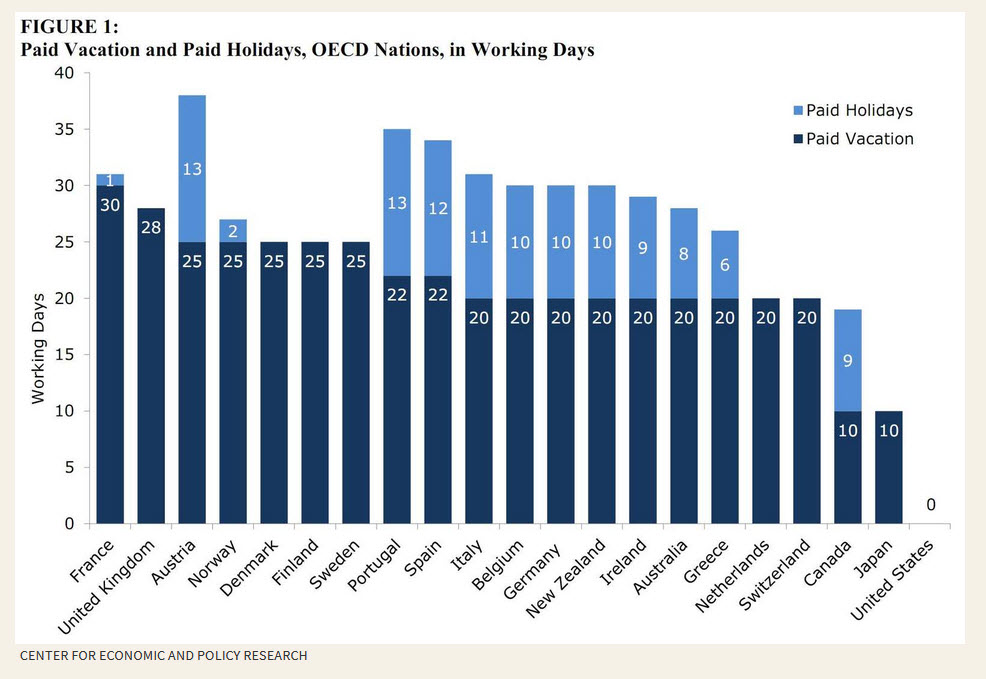
So that’s a big issue.
It results in “burnout”.
Hey! Did you know that “burnout” is an American thing. yeah. Russians, French, and Chinese don’t get it. Just Americans do.
Dear BS Job, three months ago my boss told us that we would produce a draft without discussing the project requirements with the VP first, in our boss’ words to “show we’re innovative”. Then we’d share the project with upper management, “wow them” and “invite feedback”. [Ed: I love how ‘feedback’ basically means ‘harsh criticism’ these days.] We did so, delivered on-time no less, and it sat on the veep’s desk for nearly a month. A week before product launch, VP looks at our draft, tells us it’s all wrong, and we have to redo EVERYTHING! Of course the veep blames our boss and the boss blames us, even though we did everything we were told.
A recent report has found that the United States is the only advanced economy that does not require employers to provide paid vacation time. Almost 1-in-4 Americans do not receive any paid vacation or paid holidays, trailing far behind most of the rest of the world’s rich nations, according to the report.
“No-Vacation Nation Revisited,” released earlier this year by the Center for Economic and Policy Research reviewed the international labor laws impacting paid vacation and holidays in 21 rich nations. The countries included 16 European countries, Australia, Canada, Japan, New Zealand, and the United States, all major economies that are members of the Organization for Economic Cooperation and Development.
Some highlights of the report:
For the United States:
- Workers have no statutory right to paid vacations.
- The sum of the average paid vacation and paid holidays provided to workers in the private sector ― 16 in total ― would not meet even the minimum required by law in 19 other rich countries, the report notes.
- The lack of paid vacation and paid holidays is particularly acute for low-wage workers, part-time workers, and for employees of small businesses. (Workers in small businesses are less likely to have any paid vacation (69 percent) than those in medium and large establishments (86 percent); only 49 percent of low-wage workers have paid vacation, compared to 90 percent of high-wage workers; part-time workers are far less likely to have paid vacations (35 percent) than full-time workers (91 percent).
- The gap between paid time off in the United States and the rest of the world is even larger when legal holidays are included. U.S. law does not guarantee any paid holidays, but most rich countries provide between 5 and 13 per year, in addition to paid vacation days.

For other rich countries:
- Workers in the European Union are legally guaranteed at least 20 paid vacation days per year, with 25 and even 30 or more days in some countries.
- Canada and Japan guarantee at least 10 days of paid vacation per year.
- Five countries even mandate that employers pay vacationing workers a small premium above their standard pay in order to help with vacation-related expenses.
- Most other rich countries have also established legal rights to paid holidays over and above paid vacation days.
- Several foreign countries offer additional time off for younger and older workers, shift workers, and those engaged in community service including jury duty and for activities like union duties, getting married, or moving.
“The United States is the only advanced economy in the world that does not guarantee its workers paid vacation days and paid holidays,” John Schmitt, senior economist and co-author of the report, said in a statement. “Relying on businesses to voluntarily provide paid leave just hasn’t worked.”
Rebecca Ray and Milla Sanes were co-authors of the study.
The center studied this topic initially in 2007, but since then, little progress has been made, the researchers noted.
“It is striking that six years after we first looked at this topic absolutely nothing has changed. U.S. law and U.S. employer behavior still lags far behind the rest of the rich countries in the world,” Schmitt added.
So let’s get back to “brass tacks”
People need to have a plan to manage their lives within a crazy, ever-changing society. One that is very fast, and proceeding ahead faster and faster with technological advances. You cannot count on work, society, or your government to help you out. You need to plan on how to survive within the confines of what is at your reach.
We need a plan. And it has to be better than fighting over every single penny, and grasping for every little thing.

You have skills. Improve them. Advertise them. Use them.
You are part of community. Embrace your role. Be helpful and supportive of others in your community.
Realize that no one can help you. You are on your own. And as such, strengthen your bonds with others in your local community and make sure that you and your family have a great work/life balance. It is critical for your happiness and critical for your health.
And while other nations, other peoples and other societies have it better than you Americans do, do not get all upset about that. That’s not your problem. Getting to have the same kind of happiness and life balance that they have, is.
It starts with you.
As American culture, society, and industry has become isolated from PEOPLE and their families, so has the American government. This “double tap” has caused a deep impression on the combined American psyche. And it’s not a good one. In fact, I can argue that this effect has been so horrible that it has created a downward spiral with the United States seems to be entrapped within.
Click
There was an Adam Sandler movie made in 2006 titled “Click“. And this movie take a good comedic look at the Work/life balance that exists within the United States today.
Michael Newman (Sandler) is a hard working family man, who must please his boss (Hasselhoff), in order to get promoted. Problem is he gets less time with his family, and wishes for a remote in which he can control his life. This soon comes true for Newman, when he meets Morty (Walken), a crazy sales clerk, who has the ultimate remote. A remote in which he can do anything, including muting, skipping and dubbing his life. He finds this to be the opportunity in which he can not only skip every argument, but also skip to his promotion. He sees this as a good idea, until the remote goes horribly wrong. -Written by Film_Fan
It was Adam Sandler’s most underrated movie.His role was that of a ordinary workaholic of that time trying to put up a better living for his family but he misunderstood his priorities and try to make the family happy but instead went on avoiding their company. It a fine piece of art and a wonderful chemistry of husband and wife.
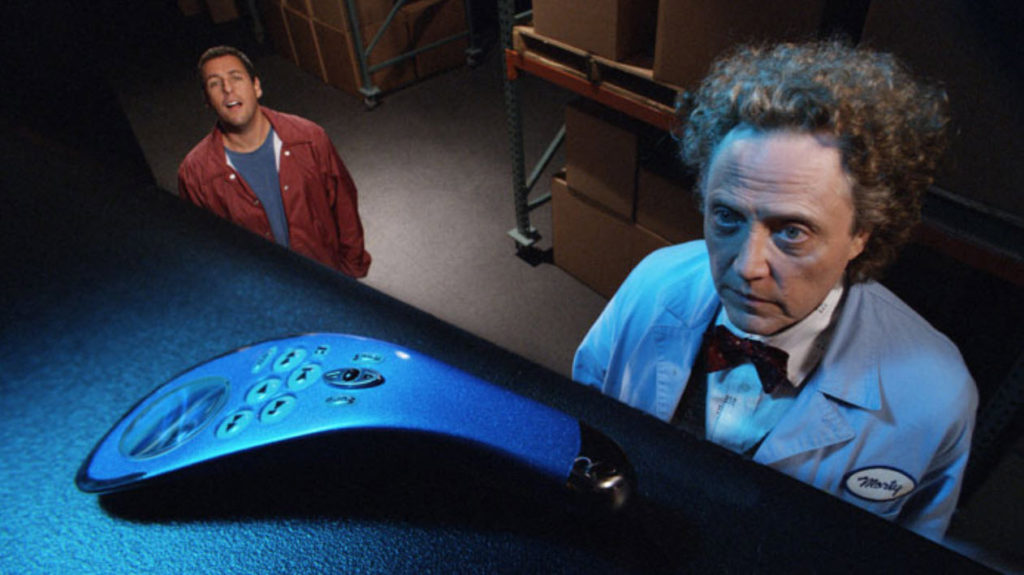
It’s a comedy, but it’s also a drama. It is something that maybe all of us need to take a good long look at.
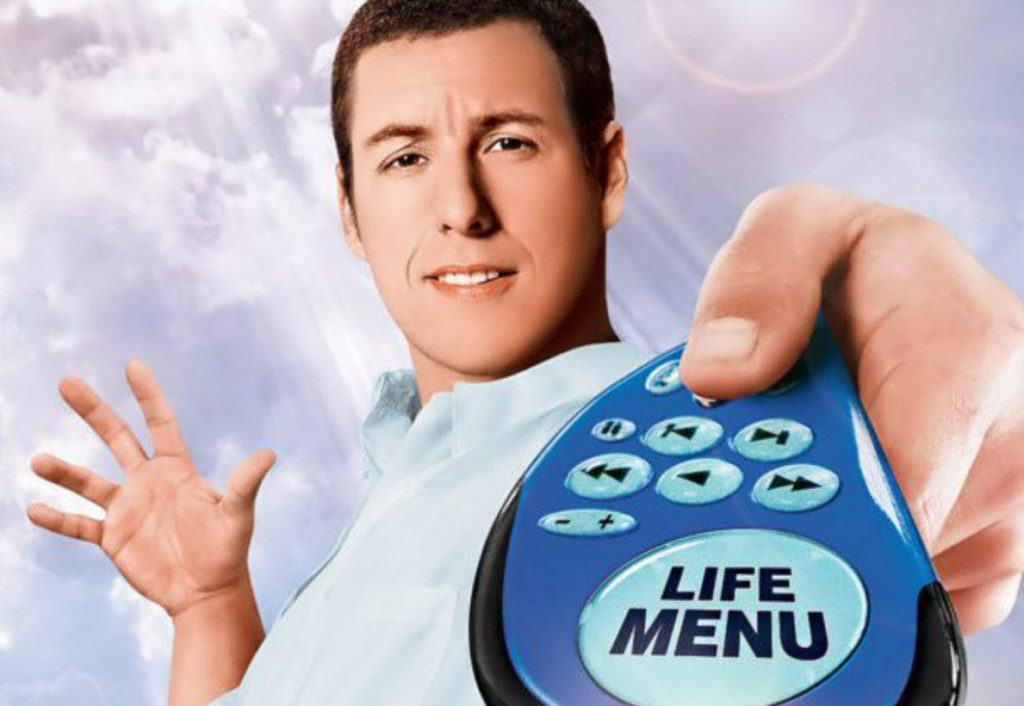 Of course.
Of course.
The movie is being sold as a comedy, but you know what? This isn’t funny. Yes, there are some laughs, as when he finds he can turn the dog’s barking up and down, or play around with the settings for hue and contrast, or when he discovers the picture-in-picture feature that allows him to watch the ballgame no matter what else is going on around him. But the movie essentially involves a workaholic who uses the universal remote to skip over all the bad stuff in his life and discovers in the process that he is missing life itself.
Take away the gimmick of the universal remote, and this is what a lot of us do, and it’s sad.
Yes.
That’s me…
…and yes. That’s you.
It’s not just sad, it’s brutal.
There’s an undercurrent of cold, detached cruelty in the way Michael uses the magical device. He turns off the volume during an argument with his wife. He fast-forwards through a boring family dinner, and later through foreplay. He skips ahead to avoid a bad cold. He jumps to the chapter where he gets a promotion. Eventually, he realizes the family dog has died and been replaced by another, his kids have grown up, his wife is married to someone else, and he weighs 400 pounds. It happened while he wasn’t paying attention.
Surprisingly good 25 June 2006I walked into the movie theater expecting to see Adam Sandler make a complete buffoon of himself. However, when I came out I was impressed. There was a depth to this movie I did not see coming, and it took me completely off guard. "Click" proved to be a powerful, emotional, and humorous piece of work. There was a certain philosophical message in this movie, in which I think, we all take for granted. Adam Sandler did a great job in playing a work-aholic.
Like many other Sandler movies, this one lingers studiously over bodily functions. After losing enormous amount of weight, for example, Michael plays with a big flap of loose skin around his stomach, plopping it up and down long after any possible audience curiosity has been satisfied. During an argument with his boss (David Hasselhoff), he freeze-frames the boss, jumps on his desk and farts. When he puts his boss back on “play,” the boss inexplicably decides his secretary has put feces in his salad. Anyone who can’t tell poop from lettuce doesn’t deserve to be a senior partner.
They teach you that in business school.
Maybe that’s why she decided to have a sex change.

But I digress…
Michael is surrounded by patient and saintly people. His wife, Donna (Kate Beckinsale), loves him but despairs of reaching him. She has that standard wifely role of complaining when he has to work late and can’t be at the swimming meet/Fourth of July party, etc. Michael’s parents (Henry Winkler and Julie Kavner) are sweet and loving but kvetch too much and talk too slowly, so Michael zaps right through the time he has remaining with them.
Like many of us do.
And then, before we realize it, they are all out of our lives forever.
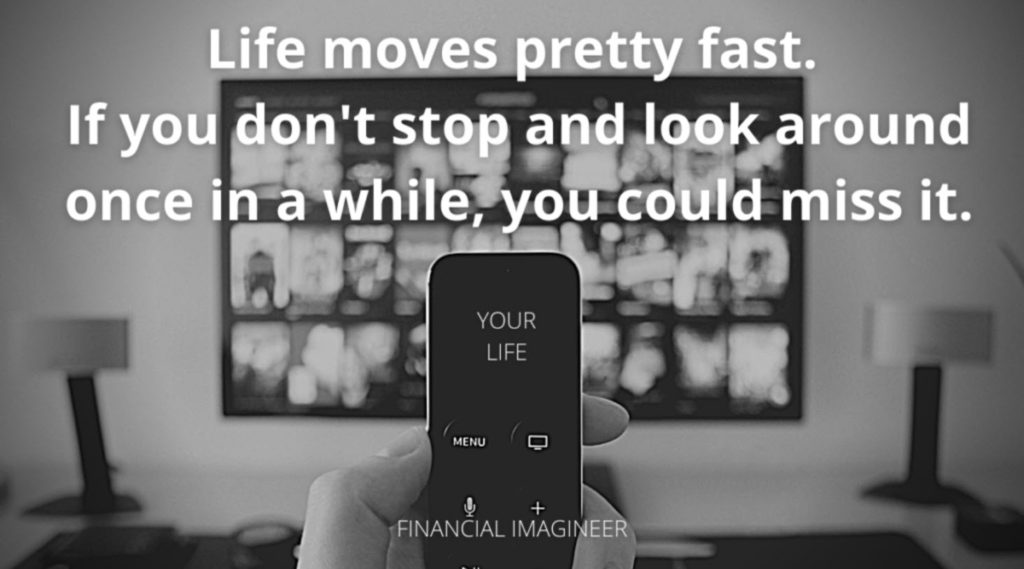
We went ahead and chased that ‘almighty dollar”. We followed our careers, and we chased after the money to “make a better life for ourselves”, but you all know… it really wasn’t necessary.
As long as you can balance your TIME with your MONEY you will be fine. It is when you mistakenly believe that you need certain “essentials” instead of time with family and friends that things end up going wrong.
Here is the handy-dandy Metallicman cheat-sheet chart to help you all plan out your life…
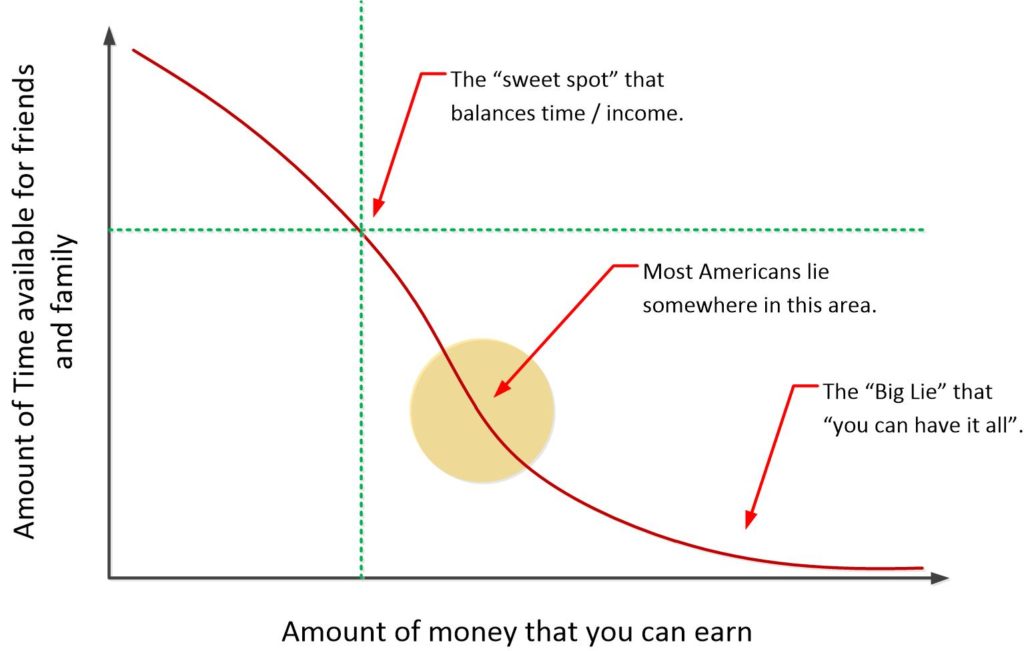
And where are you on it right now?
It’s a valid question.
Now, let’s compare the work/life balance of Americans to the rest of the world, and let’s include the modern contemporaneous HR limitations about actions and behaviors on employees when they are not at work. Compare the USA work/life balance to the rest of the world…
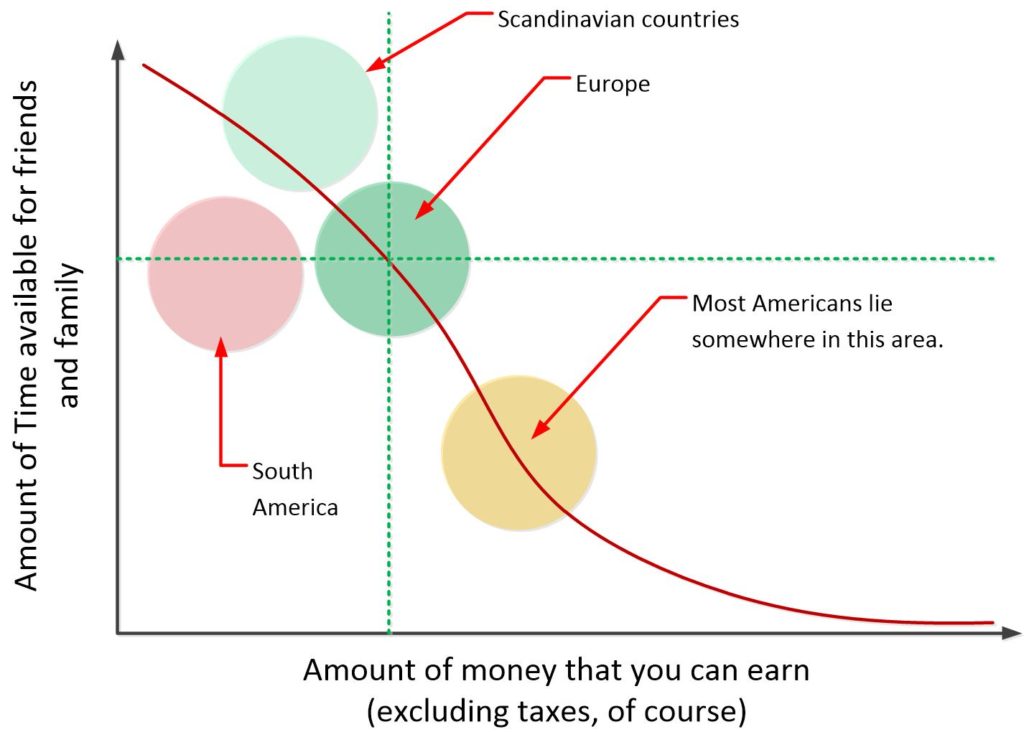
America is truly the leader …
…in making a lot of money. But how about having a decent life to go along with that money that we all earn? I mean do we all have to end up becoming a mega-billionaire in order to be able to take a day off to watch our sons play a softball game? Do we need to work long, long days all the time, jsut to be able to afford one night out a week in a restaurant?
Think about it people!
The automobile
People now drive these amazingly expensive vehicles. They have all sorts of things. Such as heated seats, power windows, power seat adjustments, wifi, super-charged engines, custom colors and interiors, and all sorts of enhancements. And yeah. That is why they are all so expensive.
And to drive these cars, we all take out loans. Because the cars are so expensive.
But really, if you can get by without a car, you could save an enormous amount of money every month. And then use that money on the down payment on a house that you could rent out instead…
…or not.
The point is that you don’t really need an expensive car. If you have a great life, with great family and fantastic friends, do you REALLY need to have the most expensive car on the block, a ski boat, a pool in the backyard, and a five bedroom, three bath, McMansion?
I argue that you do not.
My co-workers got me a birthday cake, celebration at 3pm in the breakroom. Little did they know (nor did I) that the purpose of my prior meeting at 2pm with my manager was to lay me off. I was escorted out, I am in the parking lot, one of them just texted me now, photo of cake, saying they are “eating it in my memory”. hahaha I even requested that they all wear Hawaiian shirts, including me, so I got fired wearing my f___ing flowery Hawaiian shirt. Needless to say, I got no cake either.
And with that keep in mind that this need for making more and more money is a sickness. It is ingrained in our American culture and it is resulting in some very disturbing trends. Obesity, death rates, addictions, crime, and a general collapse of society. And any one who thinks that this all… this status quo needs to be preserved needs their head examined. It needs to change.
It needs to change.
Change starts with you.
I see cracks in the society that embraces this sickness, and while it all appears worrisome, it shouldn’t be. It should be welcomed. Because change is long, long overdue. America has to change. It’s citizens are dying in the society that the government has constructed for it.
Change starts with you.
Make your life a good one.
Do you want more?
I have more posts in my life and happiness index, here…
Life & Happiness.
Articles & Links
You’ll not find any big banners or popups here talking about cookies and privacy notices. There are no ads on this site (aside from the hosting ads – a necessary evil). Functionally and fundamentally, I just don’t make money off of this blog. It is NOT monetized. Finally, I don’t track you because I just don’t care to.
To go to the MAIN Index;
.
- You can start reading the articles by going HERE.
- You can visit the Index Page HERE to explore by article subject.
- You can also ask the author some questions. You can go HERE .
- You can find out more about the author HERE.
- If you have concerns or complaints, you can go HERE.
- If you want to make a donation, you can go HERE.
Please kindly help me out in this effort. There is a lot of effort that goes into this disclosure. I could use all the financial support that anyone could provide. Thank you very much.



I still think there is a good chance America can anyday declare an outright chip sanction to all of China. As in no chips go to China period, thus overnight forcing all companies to pull out and go to Vietnam or India. It would cause global pain but then again so did Covid. This is the only chance America has of rerouting the global supply chain by using the technological chokehold and pressure points to hold the world hostage and force everyone to bypass and isolate China. It would be a bold risky move but its the best remaining trick the US has left
US will figure that short of full scale nuclear war, that this wholesale chip ban would be last ditch effort.
In the 4th industrial revolution and the age of AI, chips and chip fabbing supply chain are the new oil and America has found its new OPEC; Cutting China off all chips will be akin to oil embargo of Japan
Like WMD pretext for invasion of Iraq, they have lined up the genocide declarations to make this more platable when they take this action and the economic toil that comes from this will be blamed on the “China Virus” and how China owes the world reparations
I hope this never happens but I wont be least bit shocked or surprised if/when it does… If I was the US and saw my hegemony slipping away and nothing else has really worked so far, its what I would do.
A blanket chip ban (as in no chips can even enter China even if only to be used strictly for the manufacturing process of a US product by a US company, example if Intel chips can no longer be shipped to China then Dell cannot make its laptops inside of China anymore and will be forced to pull out etc) is much more devasting than even the threat of kicking China out of SWIFT. Money is a human social construct and the world doesn’t actually need a defacto global reserve currency, literally when push comes to shove even a barter system would more or less work, and with the technology available today, if the US were to kick China out of SWIFT, the rest of the world can adopt the Chinese eYuan in the blink of an eye, there is no reason to use the US dollar when it comes down to it.
But an all out chip ban would be much more different. You cannot cheat the laws of physics, either China can make its own chips or it cannot. In this modern digital age chips are everything, or rather they are the critical element without which you don’t have the Internet of Things, almost all modern appliances uses chips, almost all of these smart devices, even cars, to refrigerators, to basically every concievable component these days either has a chip or relies on the use of a chip in its manufacturing process. In fact we cannot even make a chip without using another chip, nor in this age can we create a compiler without using another compiler or design a computer without using a computer etc…
So how they would go about effecuating this end goal or strategic objective would be any number of options but in terms of likelyhood and explaining the “MO” of its past adventures, most likely a Gulf of Tonkin/ USS Liberty type of “Operation Northwoods” false flag in or around the SCS/ECS/TW area to be framed/blamed on China as the aggressor to spark a regional kinetic action that may or may not involve the missile strike of TSMC. (whether by the Chinese or American side) After such a kinetic event is when the US would declare an outright chip ban on all of China and that any nation that went against this would itself find itself on the recieving end of kinetic action…
US can only use this card once, but it can still do one last punch in China stomach by declaring an immediate and total ban of chips to China… it knows backtracking to a preTrump ban is already too late, China will make max effort towards independence from now on no matter what, so its only card left is to dig in even more deeply and go for max ban to speed-bump China as much as possible even if it cannot reverse the tide long term…
Even if China master all technology in the world right now, it would still need to trade for raw resources.
China only has five years of oil left, without imports its economy would collapse.
That fast nuclear breeder is at least 20 years away from commercialization and scaling up… minimum… thats not soon enough to save China if the entire world were to cut if off, fusion is much further away…
Of course these are extreme examples, Im sure even in absolute worse case some countries would still trade with China but you get the point…
China needs to up the infowar game and its pitch to the world should be that US hegemon tax is going to kill the world by constriction and that a strong counterbalancing China is in the best interest of mankind, that China can offer the world a better deal…
Biden already pitching “America is Back” meanwhile Trump says he is presumptive nominee 2024
Its all an elaborate act, the US inflicting 5th Gen infowar on the world
https://web.archive.org/web/20210120134002/https://pastebin.com/i46C4iRv